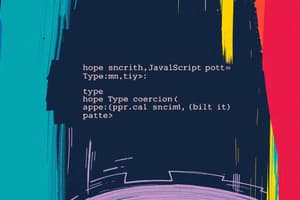Podcast
Questions and Answers
What is the primary reason that the expression 5 == "5" evaluates to true in JavaScript?
What is the primary reason that the expression 5 == "5" evaluates to true in JavaScript?
- Both values are strictly equal.
- The numeric and string types are always considered equal.
- JavaScript does not support type comparison.
- JavaScript automatically converts them to a common type. (correct)
Which of the following terms best describes the process occurring in the expression 5 == "5"?
Which of the following terms best describes the process occurring in the expression 5 == "5"?
- Weak Type Comparison (correct)
- Strict Type Coercion
- Type Casting
- Dynamic Typing
What is NOT a characteristic of JavaScript's handling of different data types during comparison?
What is NOT a characteristic of JavaScript's handling of different data types during comparison?
- It always treats different types as equal when using `==`.
- It uses type coercion to make comparisons.
- It converts strings to numbers when compared with numbers.
- It throws an error if types do not match. (correct)
Which of the following would correctly describe the behavior of 5 === "5" in JavaScript?
Which of the following would correctly describe the behavior of 5 === "5" in JavaScript?
What would be the result of using the comparison 5 == 5.0 in JavaScript?
What would be the result of using the comparison 5 == 5.0 in JavaScript?
Flashcards
5 == "5" evaluates to true because?
5 == "5" evaluates to true because?
JavaScript converts values to a common type for comparison.
Weak Type Comparison
Weak Type Comparison
A comparison that allows different data types to be compared by converting them to a single type.
Behavior of 5 === "5"
Behavior of 5 === "5"
The expression will return false because the type and value must match exactly.
Result of 5 == 5.0
Result of 5 == 5.0
Signup and view all the flashcards
Study Notes
JavaScript Type Coercion
- The code demonstrates a concept in JavaScript called "Type Coercion"
- Type coercion is the automatic conversion of data types in JavaScript to enable comparisons and operations
- In this case, the
==operator triggers type coercion, converting the string"5"to a number5before comparing both values - While the values are of different data types, type coercion allows for comparison, resulting in
truebecause5 == 5is true.
Studying That Suits You
Use AI to generate personalized quizzes and flashcards to suit your learning preferences.



